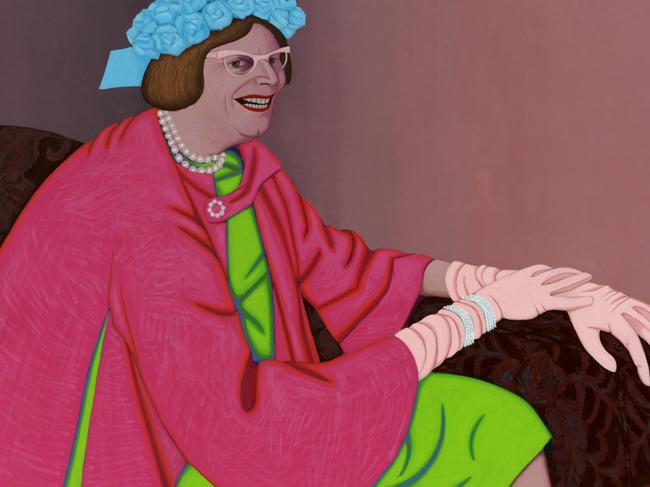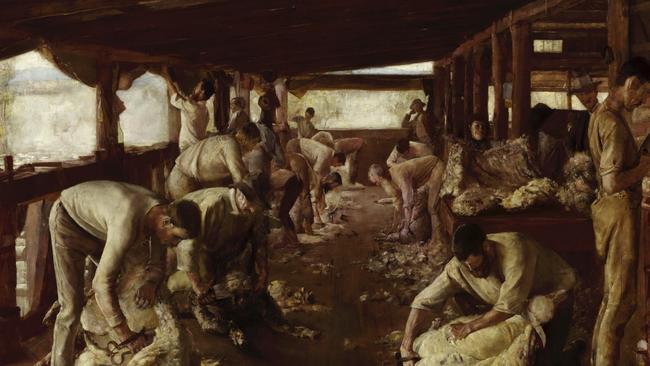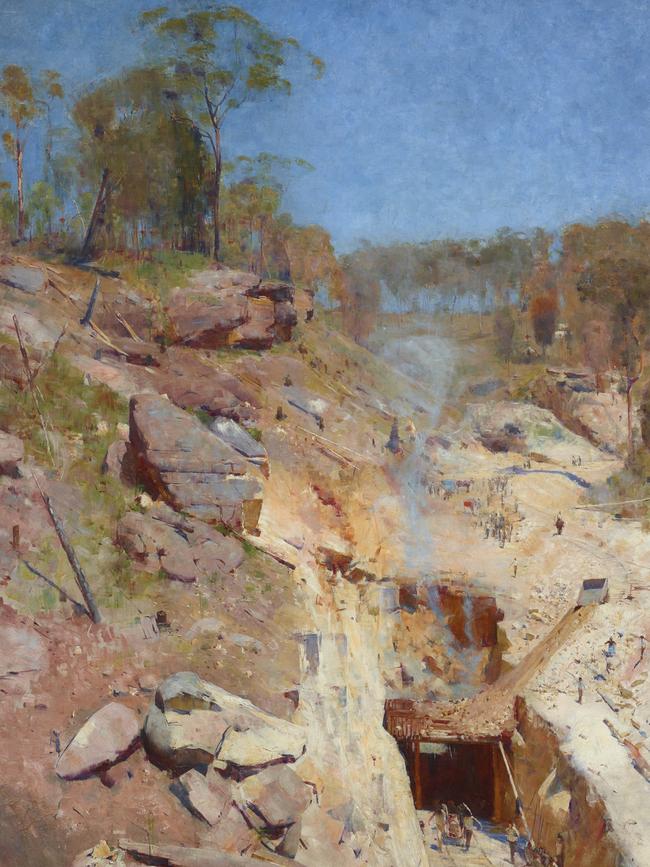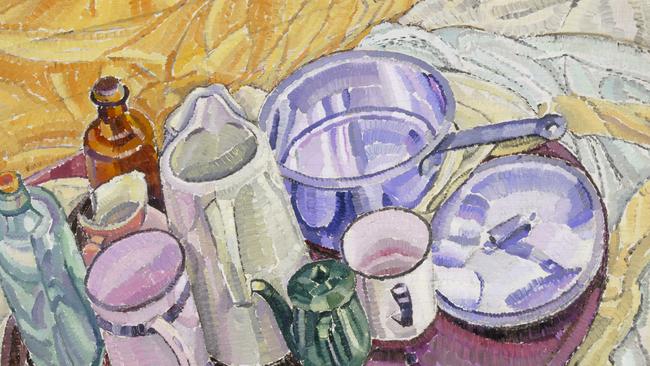A new book on Australian art reveals true depth of talent
The real interest of this book is that it contains so much on Australian art, both in detailed information and especially in intimacy of engagement and in quality of insight, that is nowhere to be found on the great information supermarket of the web

In one of the many essays in this beautifully produced volume of his collected writings, Daniel Thomas, former curator of Australian art at the Art Gallery of NSW and the National Gallery of Australia, and director of the Art Gallery of South Australia, writes of returning from a period overseas and seeing the work of David Strachan in a new light: “It was in 1967, having returned to Sydney after a long overseas liberation from parochial Australian issues, that I first consciously noticed how good Strachan’s paintings were. The paint handling was honest, direct, craftsmanlike; it covered a surface with open affection. The layers of colour were breathing, sonorous. Forms of great visual inventiveness were modelled with clarity, were held in proper relation to the picture plane by subtle networks of twigs and foliage, were arranged in carefully adjusted surface patterns and firmly related to the framing edge. The pictures were superbly unified, they had been brought to completion, they had a wonderful sense of wholeness.”

This passage (p. 73) is worth quoting at length for several reasons. Perhaps above all it reminds us of some of the infinitely complex and subtle things that go into the art of painting. Even today many people, inside and outside the art world, naively imagine that painting is a matter of copying what the artist sees, and then admire what they take for an accurate reproduction or dismiss what they think of as an obsolete way of responding to the world of appearances.
In fact, a painter looks at the world but no more copies it than a novelist or a filmmaker does. Even when a particular site is the subject of a landscape, or a set of objects on a table the basis of a still life, the painter has to translate elusive and changeable visual data, and even more importantly the intangible presence latent in what is seen, into objects of an entirely different order, composed of layers of pigments that must be brought into harmonious relations with each other; and these painted, artificial forms must be subordinated to the abstract geometry of the picture plane and the frame.
I found these remarks about Strachan particularly interesting for another reason. In 2019 when I reviewed the Margaret Olley retrospective in Brisbane I realised that the period Olley spent in her close friend Strachan’s house in Paddington in Sydney after his untimely death in a car accident in 1970 was decisive in her development. It was clear that her style was deeply influenced by his during this time. But what she effectively learnt in her imitation of Strachan’s work was precisely the formal qualities that had been lacking from her early pictures and makes them weak by comparison with her subsequent compositions.
More generally, however, this passage epitomises what visual literacy, to use that rather unappealing term, really means; it is above all awareness of the language of painting, which includes the formal qualities that we have mentioned as well as historical style, genre, iconography, and so on, just as the reader’s literacy is awareness of the style and tone of writing, generic affiliations and echoes of earlier authors, the pace of prose, the metre and music of poetry.
Sadly, visual literacy is scarce in contemporary art writing. The problem starts with the fact school art curriculums are the works of visual illiterates, who think that making art starts with having a message or issue that you want to comment on and that you wrap up like a parcel in some art form or other. Actual instruction in particular studio disciplines is usually perfunctory.

here is thus a direct line from the miserable productions of most high school art departments to Biennale catalogues, where entries on artists inevitably start by telling you that the individual is deeply concerned by social justice, racism, sexism, and so on, before mentioning as an afterthought what their “practice” consists of. Needless to say, no good art starts with such concerns; it may ultimately touch on such themes, but art has substance only when it begins from and is grounded in the embodied thinking of practice.
Thomas’s visual sensibility is matched by the ease and fluency of a literary style that can be razor-sharp in its articulation of critical subtleties, but always remains conversational, intimate and civilised. I was intrigued to see that he loved Charles Lamb’s essays as a schoolboy; I remember a headmaster recommending them to me too as a model of prose. Above all, Thomas’s writing is entirely free of the vices that infect contemporary art writing: pomposity, ideology, moral indignation and breast-beating which is the hypocrite’s way of patting himself on the back.
Unburdened by this paraphernalia, his style is free and clear, addressed to a literate public capable of drawing their own conclusions. Of Dorrit Black, for example, he writes (p. 280): “But the unmarried middle-aged daughter was soon called home to Adelaide to care for a widowed mother.”
So much about the woman, the social environment, the assumed customs of the day, is economically contained in this simple sentence, which an intelligent reader understands without the heavy-handed editorialising that would be almost inevitable today.
He is perceptive, critical and discriminating too — all rare qualities now that few writers about art are more than publicists for institutions and the art market. From as early as 1963, for example, there is a remarkably insightful note on Fred Williams (p. 36) that not only identifies both the literal and formal characteristics of his painting but includes an illuminating comparison with John Olsen.

Later there are examples of the depth of analysis that comes not from imposing a prefabricated theoretical model on a work of art, let alone a set of predetermined conclusions, but from close study, detailed knowledge and intimate engagement with the object.
A model of this approach is Thomas’s reading (p. 209) of Grace Cossington Smith’s Interior in Yellow (1962-64). There is much one can say about this picture purely on the basis of what we are given to see — an interior from which the outside world is glimpsed only indirectly in the reflection of the wardrobe mirror — but it adds considerably to our understanding to realise, among other things, that this is the house where the artist has lived since her childhood, that her bedroom had once been that of her parents, and that this is the bed in which her own mother had died.
Besides such gems of close analysis, there are pieces in which much broader subjects are tackled. A particularly good one is his account of the long and underestimated tradition of interest in Aboriginal art in the 19th and earlier 20th centuries, before the commercial feeding frenzy of the past 30 or 40 years. Thomas is tactful but penetrating when he observes (p. 273): “Aboriginal art by then, the 1990s, had been fully transformed in art suitable for the art museums and the upper reaches of the art market.”
Important points are made in the course of reviewing books, such as Joan Kerr’s Dictionary of Australian Artists (pp. 131-32) and in one obituary after another, as first precursors and then contemporaries have passed away. The piece on Mervyn Horton — with among other things the unexpected explanation for his goatee beard — (pp. 224-25) is a fuller and more colourful version of the text eventually published in the Australian Dictionary of Biography, although it is in an aside on p. 60 that we learn that Horton altered his will when Thomas moved from Sydney to Canberra, so that the NGA is today the owner of Cossington Smith’s Eastern Road, Turramurra.
Other obituaries recall some of the complex and interesting characters who once worked in Australia’s art institutions, people such as Robert Rooney (pp. 300-02), Ruth McNicoll (pp. 202-03) or the legendary and wonderfully eccentric Nicholas Draffin, first curator of prints and drawings at the AGNSW — “a natural scholar can teach himself anything” (pp. 150-51).
There are fewer individualists in the new corporatised world of Australian public galleries, with their box-ticking concern for “diversity” and ingrained love of the mediocre. And in any case, curators have been firmly downgraded in favour of a proliferation of highly paid administrators with increasingly ridiculous titles.
Everywhere there are mines of unexpected information about Australian art, artists, scholars and collectors: thus in one piece (pp. 173-75), Thomas reveals that the art collection of Sir Edward and Ursula Hayward was once more risque, and that several pieces were deaccessioned before the house and its contents were left to the state of South Australia. The most significant of these were three erotic works by Stanley Spencer, many of whose less confronting pictures remain at Carrick Hill today. Jeffrey Smart was with the Haywards in London when they bought the most explicit of these, which eventually was taken back to straitlaced Adelaide by Nora Heysen among a set of floral still lifes; the Customs officers must not have looked too closely.
Charming anecdotes abound: it turns out that Martin Sharp asked a teenage Cressida Campbell to draw a self-portrait on a large panel, which he then painted and turned — across two years — into Miss Australia (pp. 80-81), combining Campbell’s recollections of Picasso’s Demoiselles d’Avignon (1907) with colouring borrowed from Matisse.
It is probably apparent from all this that I read Recent Past with pleasure. That should come as no surprise, but it does remind us how rarely we can ever read anything written about art today with enjoyment; usually it is with gritted teeth at the combination of adolescent illiteracy in the form and undigested ideology, moral posturing and blatant promotional puffery in the content. As for Biennale catalogues, they are not even meant to be read but simply to be interred with the exhibition, like grave goods.
I read Thomas’s book not only with pleasure, but with absorption on two long train journeys from the Shoalhaven to Sydney and then back again. On the first of these trips I was still reading in the underground from Central to Kings Cross when a rather bedraggled and tipsy old man sitting opposite me suddenly said: “That’s a big book.” Then after a pause: “You don’t see many big books like that any more.” After a further interval for reflection, he added: “These days it’s all on the internet, isn’t it?”
Well, a lot is on the internet these days. Most of the basic facts you might need to know about the artists discussed in this collection can indeed be looked up quickly and easily on Wikipedia or Google. But the real interest of this book is that it contains so much, both in detailed information and especially in intimacy of engagement and in quality of insight, that is nowhere to be found on the great information supermarket of the web.

